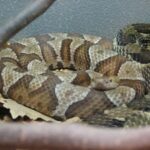The red lionfish, pterois volitans, is also known as the turkeyfish, peacock lionfish, butterfly cod and zebrafish (among others). They measure from 11.8 to 15 inches (30 to 38 centimeters) in length and their maximum weight is somewhere around 2.6 pounds (1.2 kilograms). They have red (as their name implies) and white stripes as well as elaborate fan-like pectoral fins and long, separated dorsal spines all around their bodies. These fins and spines are venomous and are used to hunt prey and defend themselves from predators. They also have fleshy tabs around their eyes and mouth.
The red lionfish can be found in the western and southern waters of the Pacific Ocean. They have also recently been found along the eastern coast of the United States. They will inhabit harbors, turbid inshore areas, offshore reefs and lagoons at depths of up to 164 feet (50 meters). They will take shelter under ledges or within caves or crevices during the day. It is thought, however that they may retreat to these areas only after they have fed, making it unclear whether they are really nocturnal or not. They will exhibit a nearly motionless posture while in their shelters, with their heads tilted slightly downward. This animal is usually a solitary species (except during mating season), hunting and traveling alone.
The diet of a red lionfish consists of small fish, shrimp, and crabs. They will stalk their prey and then corner it, maybe even using its venomous spines and fins to incapacitate the prey. The victim will then be consumed by a quick snap of the jaws and swallowed whole. It is unknown as to what natural predators this creature actually has. Having such a solid and dangerous defense makes eating them a risky affair. It is however, thought that cornetfish may successfully hunt them as well as some shark species as they are known to eat venomous creatures without consequence.
Breeding for the red lionfish is not well documented. Males will court females with fin and spinal displays and gather them up to form groups of 3 to 8 fish. Females will release a pair of mucus-encapsulated clusters that contain anywhere from 2,000 to 15,000 eggs into the water, which are then fertilized by the male. Larvae will hatch after around 36 hours from fertilization. They will remain larvae for around 20 to 40 days before metamorphosing to an adult red lionfish.
Red lionfish are not an endangered species and in fact, they may even be expanding into different territories. This could prove problematic for other native fish in their new ranges and research is currently underway to see how much of an impact this could have. These animals could also be exploited themselves as they are popular pets and a favorite food among people. Monitoring this species is necessary to not only make sure that they are safe, but to also make sure that their expansion does not prove dangerous for other aquatic wildlife. Hopefully, a balance can be found to help this aquatic animal without causing problems for other sea life. After all, such a unique species deserves to live and prosper far into the future.
Works Cited
“Species Name: Pterois Volitans” 5 June 2011
“Red Lionfish” 5 June 2011


